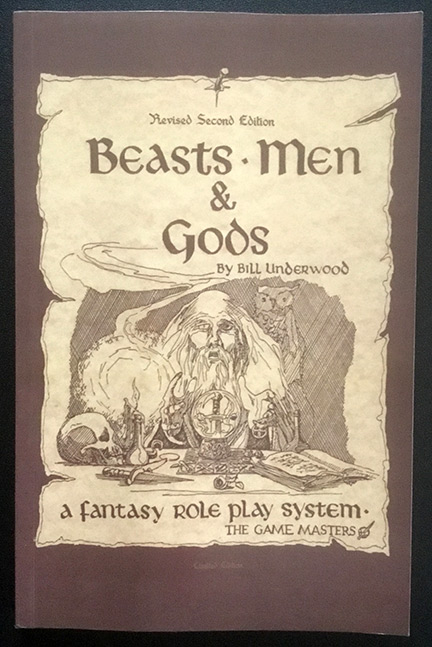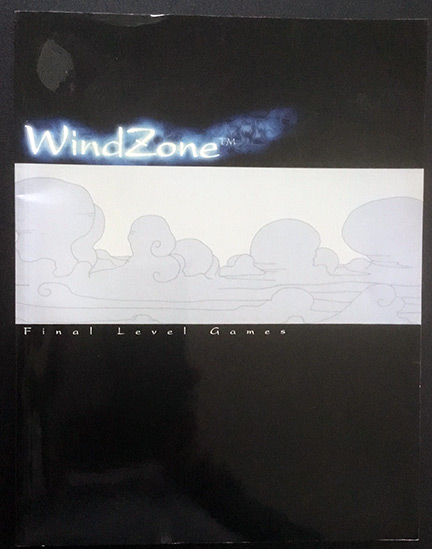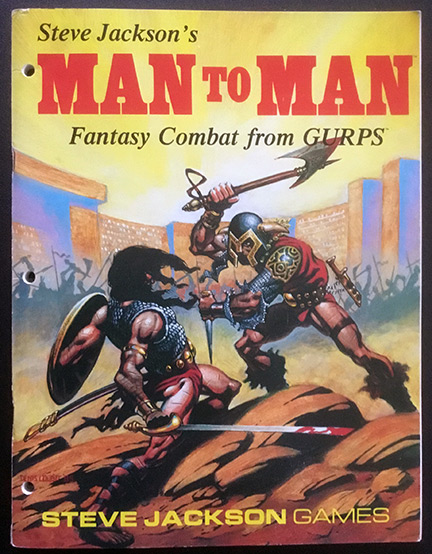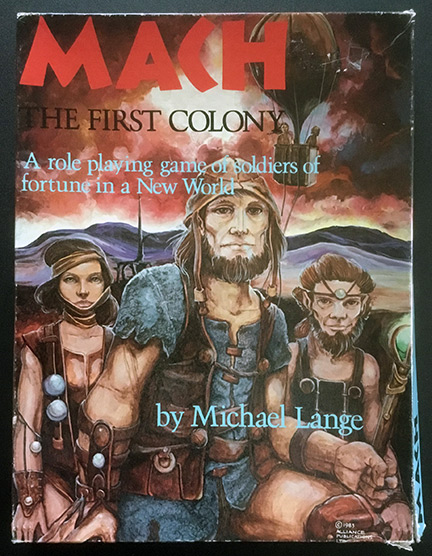|
 |
|
This is part 8 in a series discussing forgotten RPGs (also see Part 1, Part 2, Part 3, Part 4, Part 5, Part 6, and Part 7). That is, games most people have never heard of or that didn't last long on store shelves for one reason or another. This batch is an eclectic mix. Most of these games have been sitting on my shelf for years, mostly ebay finds to add to my collection.


1. Beasts, Men & Gods (by Bill Underwood; originally published by The Game Masters in 1980, Revised 2011 Edition)

Offputting is the courier-like font. Despite that, it has a clean layout, so let's not allow it to get in our way. Straight to statistics. There are nine: strength, constitution, intelligence, wisdom, dexterity, bowskill, charisma, personal appearance, and willpower. They are rated from 3 to 18 like D&D, but I won't get into the rolling process for it, which uses a novel way to avoid too low or too high, although it does seem like a statistic could go to 21. There are no skills, but there are some calculatd values. The usual basic classes are here, plus a forester. Statistics provide modifiers similarly to D&D, but they are generally percentages. There are also saving throws, which use percentages based on statistics (formulas): agility, bleeding, magic, poison, shock, stress, unconconsciousness. There's some other elements like a belief bonus, which is the mental equivalent of armor class. This description really doesn't do all the rules justice, but it's a lot to detail. Combat is interesting, with speed being a factor, and modified by weapon reach and specifc actions. The basic combat roll is D% + hit bonus vs. opponent's armor rating. Lots of options, like hit location, critical hits, and berserking. The rest of the book is filled with monsters, gear, magic items, spells and magic notes. I really like this game. It's old school, so there are a lot of computations involved, but once you have them down on your character sheet, everything should run fairly smoothly. You can still get it via amazon.




2. Ultimate Power (by Blake Mobley; published by The Game Lords in 1994)

This seems to be a more basic version of the publisher's huge Metascape game. When I say huge, I don't mean how popular it was, because I never heard of it back in the day. When I say huge, I refer to its very large box, but I'll save that one for another day. First off, if you open the book to a random page, you may mistake it for the original TORG game. Its trade dress is very similar. Even the character sheet is reminiscient of it. After learning of how this is the ultimate game tool that goes beyond any traditional RPG, we first get to the die system. You need the following dice: D6, D8, D10, and a special D16 multiplier (t, c, x1, x2, x4, x8, and x16). There are three tables: Light, Medium, and Heavy. Each roll is designated for a specific die (except the D16) and a table. You roll that die AND the D16. You then consult the appropriate table with the number rolled and the multipler rolled to get a final result. If you rolled a x16 on the D16, you get to roll it again, and multiply the original result with the new multiplier. Rolling the c on the D16 means that a lower table is used and the D16 is rolled again for a multiplier. Rolling the t on the D16 lowers the scale of the roll by one (vehicle, personal, etc.). It seems like it was their take on making a value system (like TORG/MasterBook) that could interact on all levels, albeit in a more convoluted way. I'm not sold on the mechanic, but neither am I writing it off. Our attributes are: luck, dexterity, fortitude, speed burst, strength, awareness, charisma, intelligence, will power, initiative, vitality, movement rate, and carrying capacity. Apparently, you grade each attribute, skill, power, etc. as desired, as poor, low, average, good, high, or extreme. These cost points that are calculated after the fact. When it's all said and done, you can convert the grade to a rating (the die rolled and table) and a value (such as for movement). As I mentioned, this is the basic version of rules. It's not really my thing.




3. WindZone (by Michael Paul Simon and Alan Jay Payne Jr.; published by Final Level Games in 2003)

I'm hoping this one is a bit more straight-forward. The world is flat. There's no sun, moon, or stars. Just the wind. It brings light and everything else. After a brief description of the world, we are faced with the basic rules. There are three types of die rolls: D%, XD10, and 1DX (max is X, with the numbers repeating up to X on a d10). Now we get to the races. There's a mix of flying species, humanoids, amd felinoids. There are six primary statistics (0 to 30): speed, dexterity, strength, intuition, intelligence, and wind affinity. There are huge tables for for flight, secondary statistics, etc. Skills come in levels, and each race has a package of skills. Note that wind is the mystical element in this game, allowing for special powers. Tap into the wind and you can do special things. I like that concept. Let's see how the actual mechanics are. You add 10 per skill level to the appropriate statistic (they changed it to ability score here -- I hate that, as I need consistency). That becomes the D% target number. Harder technical skills would add less if the technology is of a higher level. Combat is similar, with the opponent able to make a defense roll. The rest of the book consists of powers, weapons, vehicles, rules for survival, and descriptions of the people and creatures of the world. I bet this would have done really well if it was released as a d20 setting. The author is still selling this as a PDF for those who wish to check it out.




4. Man to Man (by Steve Jackson; published by Steve Jackson Games in 1985)

I'm sure most of you have heard of GURPS, but have you heard of this preview of GURPS? Man to Man is essentially the basic character creation and combat system from GURPS for fantasy games. Put another way, it's advanced Fantasy Trip. It is put together nicely with the basic instructions for creating [original GURPS]-compatible characters. Since GURPS is very well-known, I am not going into detail on this. Similar to The Fantasy Trip, it also includes some blank and terrain-filled hex sheets, flat counters, and sample characters to start battling it out. There are a number of reference sheets and more advanced rules. This would have been a fantastic purchase back in the day, even with a full version of GURPS around. To go further, I would say that an updated print version would be great for those wanting a leaner introduction to modern GURPS. You can still get this in PDF format.




5. MACH: The First Colony (by Michael Lange; published by Alliance Publications in 1982)

This boxed set is about soldiers of fortune in a New World, or so it claims. The type is realllly small, making it all flow together. The Earth was about to be caught in a blast from a supernova. A benevolent race of aliens, also trying to save their world, approached the humans about transporting them to another world. The stipulation was that it had to be shared with some other races and they would not be able to bring guns and such. Some did. The various cultures changed behaviors, some violently, others remaining peaceful. There is also evidence of ancient, native civilizations with old cities ripe for plunder. That's the gist. Character creation concerns itself with race, age, height, weight, and nine characteristics: intellect, psyche, will, strength, stamina, dexterity, speed, charisma, and appearance. The general scale for characteristics is 3 to 18+, with the race and gender determining what to roll to determine the rating. The characteristics provide modifiers for various rolls, similar to D&D, but as percentages. Various backgrounds and profressions round out the character's skills and equipment. Notably odd is that skills are not discussed until the second booklet. We've still got to get through the rules on creating colonies, followed by combat and equipment. For combat, a d8 and d20 are rolled. The d8 determines the location hit, while the d20 determines success by having to roll over the armor class. I'm not getting into armor class. It's confusing, but kind of makes sense. I think I need to play it out to wrap my head around it. Skills are purchased in blocks, which essentially determines their odds of success. There's a nice section about life forms and some appendices with special rules. The psychic powers seem pretty good too. The third book consists of an adventure, which also includes an example of character creation, with the author even suggesting that it is more complex than in other games. I like the game's concept. And while it could easily be done with any system, there were not that many back then and certainly no open ones.




6. The Valley of the Pharaohs (by Matthew Balent; published by Palladium Books in 1983)

I am particularly fond of this game, though its text is tiny. The 50-page book is also a smaller size than most, perhaps 6x9 inches in a full-sized box. Characters belong to a caste that provide possible occupations, attribute bonuses, and skills: nobility, clergy, bureaucracy, and commons. There are five attributes determined by 3d6: strength, speed, intellect, power, and persona. The occupations, such as soldier or thief, provide skills at particular ratings (formulas are provided based on attributes). Combat is handled with a d20 roll plus any attribute bonuses, rolling over the target's armor resistance factor (this is essentially the same as D&D, but without all the tables and with AAC). There are limited magic spells, but they fit the setting, and they are cast by rolling under the spell's difficulty. I could not figure out how to handle skill rolls. The introduction talks about d20 and d% rolls, as well as roll over or under saves, but I can't seem to find the section that specifies what is rolled for skills, other than it saying "roll against the skill." I take this to mean roll under on d20, but I'm not sure. Section 2 is also about Acient Egypt. It's brief, but packed with useful information and great retro-style art. There's information on the clergy and the various gods. Just enough to get you started. The very end provides a selection of animals and monsters, as well as gamemastering notes and random tables. A loose collection of folded sheets provide a number of maps and building plans. Finally, there's a basic poster map of Egypt. This is another old game available again in PDF format.




I'll be compiling another list of forgotten games soon. In the meantime, check out something intriguing like Timeship or Exiled in Eris.


Part 9... | | 3 Comments | Add Comment | Permanent Link | See All Posts Tagged as "ForgottenGames" | | Return to Overview | | Narmer Commented: | Nov 27, 2020 | 11:30 pm | |
| Brett Commented: | Nov 28, 2020 | 8:09 am | |
| Brett Commented: | Dec 01, 2020 | 6:14 pm | |
Add Comment |
 |
|
|
|
|







